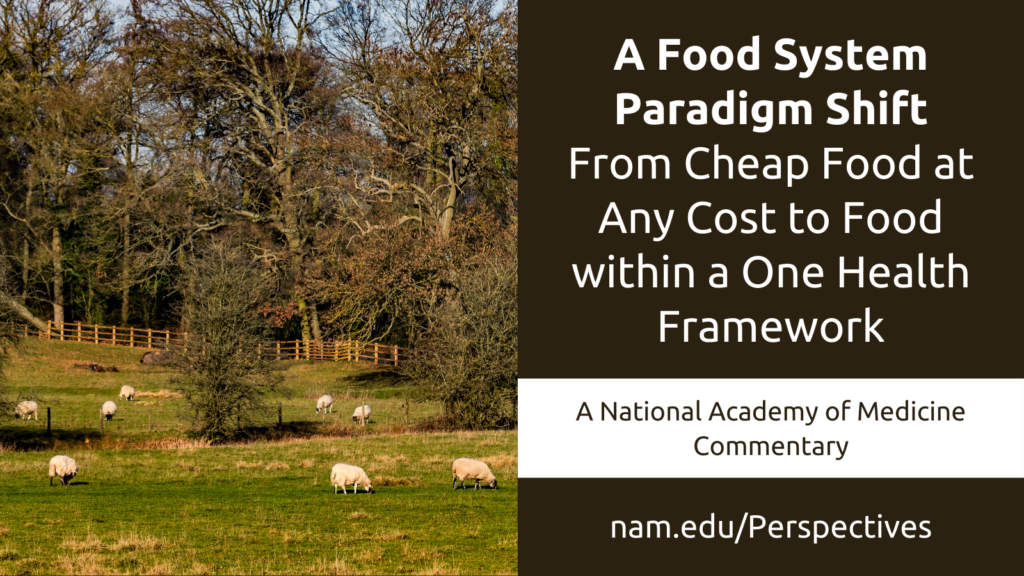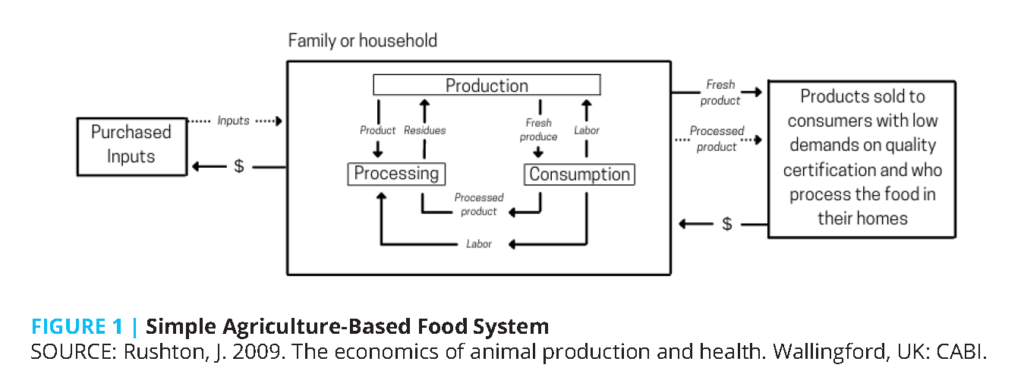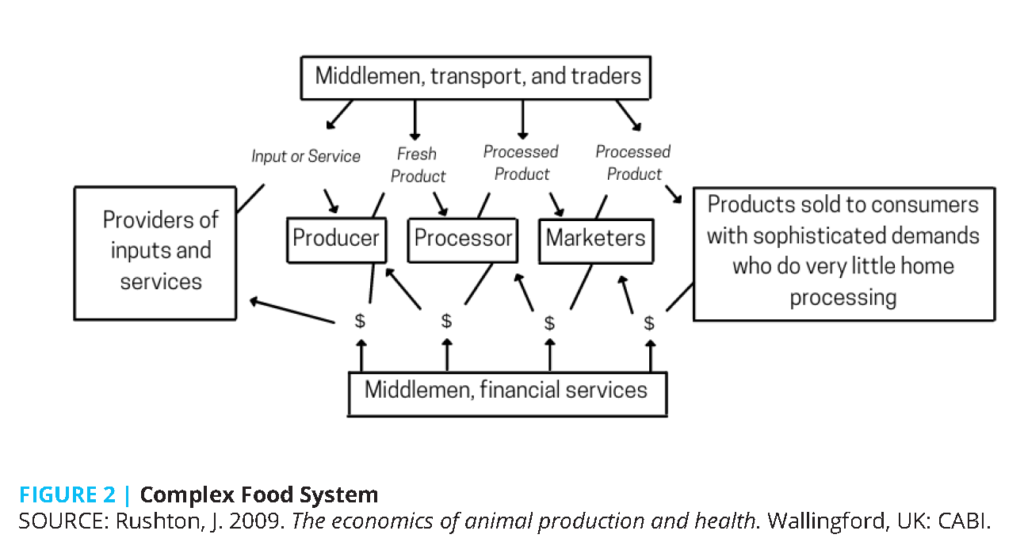A Food System Paradigm Shift: From Cheap Food at Any Cost to Food within a One Health Framework

Every dollar spent on food in the United States produces two dollars of negative impact on public health and the environment. Today’s food system feeds people but harms the environment and the health of humans, animals, and plants globally (The Rockefeller Foundation, 2021). The authors of this commentary explore how food systems have arrived at this unsustainable state and what can be done to address this crisis.
Driven by a narrow focus on economic efficiency, modern food systems have evolved to deliver cheap food at any cost. These food systems are typically guided by Ministries of Agriculture that often work in a narrow and siloed manner, function independently of Ministries of Health and Environment, are reactive to emergencies, and fail to respond proactively to the mining of natural resources and poor food-related public health outcomes (Scott and Gong, 2021). The authors of this commentary present a case for an urgent change of mindset toward systems thinking and proactive policies to curb these negative externalities (i.e., unintended negative impacts not adequately accounting for economic costs). This mindset change centers One Health, an approach that addresses the health of people, animals, plants and the environment through intersectoral and transdisciplinary methods, at the core of global food system policies (Rushton et al., 2018).
If you are 50 or older and grew up in a rural town or provincial village in a wealthy country, there is a good chance that your family was involved in agriculture. You might have gone to school with children from farms who perhaps smelled of livestock or had to take time from school to help with crop planting or harvest. You might have been aware of food shortages, the importance of water availability, the seasonality of many fruits and vegetables, and how some meats were highly prized and saved for special occasions. You might understand how food would go bad, turning rancid or becoming moldy. You may have participated in preserving your own family’s homegrown or other locally grown produce. Agriculture might have surrounded you in your younger days. You might have known farmers, been able to see what they did on the farm or in the fields, and smelled and felt what was happening to the land—you were part of the ecology of food production and processing (see Figure 1).
Two generations later, that intimate relationship with food production through agriculture has been displaced by a system that supplies foods from around the world with consistency never seen before, safety for the masses, and variety to those who can afford it. Retail outlets are immense spaces full of a dizzying variety of foods, often prepackaged. Food preparation and procurement has changed so dramatically that consumers are less likely to spend time selecting and preparing food. Instead, their food-related decisions have shifted to be more often about whether to eat at a restaurant, buy a takeaway meal, or put a readymade meal in the microwave. Fewer people cook at home (Poti et al., 2015). Many people have no concept of where their food comes from or how it is produced (Hess and Trexler, 2011). The food system has become increasingly large and complex (see Figure 2).
Agriculture has become invisible. Today’s consumers no longer see the farms, farming practices, or farmers— nor the landscapes that they shape. The change from local, agriculture-based food systems to the complex food system described in Figure 2 is among the most significant innovations of the last hundred years. Its shift has been intergenerational in wealthier countries and is intragenerational in poorer ones.
However, removing the general consumer from agricultural and food processing traditions has caused significant harm to the environment and led to many public health issues that stem from food consumption (OECD, 2019). Food prices have been driven to the low levels seen today in part because they do not reflect the full costs of using soil and the natural environment. The availability, range, and variety of relatively cheap food mean that individuals often overeat, and for people living in food deserts, fresh food choices are unavailable (Battersby and Crush, 2019). In some instances, unhealthy food choices manifest in overnutrition, leading to a high number of people who are overweight or obese (OECD, 2019). As of 2016, 39% of adults worldwide were overweight (WHO, 2021). In other situations with poor food access, there is undernutrition, stunting, and wasting. Where there is rapid adoption of complex food systems, aspects of overnutrition and undernutrition coexist in the same families, and paradoxically, sometimes in the same person (Dominguez- Salas et al., 2019). Wide access to media depicting new food products as part of a wealthy and desirable lifestyle has also led many residents of low- and middle-income countries to abandon local, healthy products in favor of unhealthy, highly processed food. Critically, food-related health problems affect not just the lives of individuals but also their children and perhaps their grandchildren (Tiffon, 2018).
Food system “advancement,” combined with technology changes and prices of nonrenewable fossil fuels, has encouraged a tendency for agricultural production systems to mine natural resources that are often undervalued by society, leading to ecologically insensitive production practices. For example, the Living Planet Report noted in 2020 that 68% of the world’s biomass of wild vertebrates was lost between 1970 and 2016 and identified human activities since the Industrial Revolution as a significant driver of this destruction. There are additional costs to this invisible use of land and water: cropping systems have become monocultures; rich, valuable soils are treated as mere substrates; ancient forests and woods are seen as an inconvenience to automation; and biodiversity is not recognized as fundamental to the health of all life on earth (Bennett et al., 2012; Poppy et al., 2014). Furthermore, livestock is no longer integrated into crop systems, and the trade-off of not allowing these animals to graze and scavenge in the natural environment means that the field has become dependent upon nonrenewable fossil fuels to produce animal feed and remove their wastes.
Societal reaction to these challenges is to ask farmers to change their practices without any empathy for the issues modern farmers face or understanding of the global food markets and trade. Yet the farmers are not the problem; the food “system” they are part of is. This system has evolved to produce cheap and plentiful food with little or no restriction on using the natural environment as an input. The system has become a process of “mining” rather than managing natural resources.
The evolution of current food systems, driven by a narrow focus on economic efficiency to deliver cheap food at any cost, has resulted in a distortion that requires a paradigm shift. A One Health approach would provide a unified framework for better oversight and management of complex food systems. One Health recognizes that the health of people, animals, plants, and the environment are one entity and are inextricably linked (Rushton et al., 2018). The health of each component cannot be separated from the others, as they are all interrelated and interconnected. One Health embraces the need to look at the food system as a whole to understand the interlinkages and the influences that each decision may have on the management and use of the land, air, and water. Centering future policies in One Health requires stakeholders to aim to achieve a balance between systemic management and influencing individual behaviors, with neither alone being sufficient. Agriculture is the foundation of civilization. Humanity must discern how it will feed nine-billion-plus people without further destroying the environment. If we destroy our environment, we destroy ourselves (WWF, 2020).
The authors of this commentary propose a One Health paradigm that respects food production as part of the ecology of natural systems, values soil and water, lauds people and businesses that tread lightly on that ecology, and seeks food systems that deliver nutritious foods to support good health in humans and animals. This One Health vision requires supportive policies from and with organizations empowered to address food system challenges. Under a One Health framework, the true cost of food would consider and endogenize food systems-related costs to public health and the environment. This new paradigm needs data governance platforms that collect and analyze data in real time to be proactive in developing metrics and monitoring how One Health outcomes are being achieved (see Figure 3).
These lofty ambitions may be countered by arguments of food cost and availability, and the danger that new governance systems will not be given sufficient resources and power to deal with the scale of the existential problems that have been presented. It will not be easy. However, the alternative is business as usual, muddling along with discrete and incremental changes that, as highlighted, do not address the worsening negative impacts on the environment and public health with the very real potential of the eventual collapse of the food system and civilization itself (Mehrabi, 2020). Brave, bold policies that can withstand the tide of criticism and produce an institutional environment where the true costs of food reflect the value of natural resources extracted are needed. Food needs to be of a quality that delivers long-term positive public health outcomes. The systemic flaws in our food systems that dominate land and water use, employment, transportation, and health require oversight by a public body that can monitor, evaluate, coordinate, and, where necessary, regulate the food system.
Join the conversation!
![]() Tweet this! Authors of a new #NAMPerspectives commentary examine the current global food system and call for a #OneHealth approach that would center the health of people, animals, plants, and the environment: https://doi.org/10.31478/202111b #NAMPerspectives
Tweet this! Authors of a new #NAMPerspectives commentary examine the current global food system and call for a #OneHealth approach that would center the health of people, animals, plants, and the environment: https://doi.org/10.31478/202111b #NAMPerspectives
![]() Tweet this! “A #OneHealth paradigm respects food production as part of the ecology of natural systems, values soil and water, and seeks food systems that deliver nutritious foods and support good health in humans and animals.” Read more: https://doi.org/10.31478/202111b #NAMPerspectives
Tweet this! “A #OneHealth paradigm respects food production as part of the ecology of natural systems, values soil and water, and seeks food systems that deliver nutritious foods and support good health in humans and animals.” Read more: https://doi.org/10.31478/202111b #NAMPerspectives
Download the graphics below and share them on social media!


References
- The Rockefeller Foundation. 2021. True Cost of Food Measuring What Matters to Transform the U.S. Food System. Available at: https://www.rockefellerfoundation-True-Cost-of-Food-Full-Report-Final.pdf (accessed October 14, 2021).
- Scott, I., and T. Gong. 2021. Coordinating government silos: challenges and opportunities. Global Public Policy and Governance 1:20–38. https://doi.org/10.1007/s43508-021-00004-z.
- Rushton, J., L. R. Nielsen, L. Cornelsen, K. Queenan, S. R. Rüegg, and B. Häsler. 2018. Evaluation of integrated approaches to health with a focus on One
Health. In Integrated approaches to health. A handbook for the evaluation of One Health. Wageningen Academic Publishers, Wageningen, The Netherlands. https://doi.org/10.3920/978-90-8686-875-9. - Poti, J. M., M. A. Mendez, S. W. Ng, and B. M. Popkin. 2015. Is the degree of food processing and convenience linked with the nutritional quality of foods purchased by US households? American Journal of Clinical Nutrition 101:1251–62. https://doi.org/10.3945/ajcn.114.100925.
- Hess, A. J., and C. J. Trexler. 2011. A Qualitative Study of Agricultural Literacy in Urban Youth: What Do Elementary Students Understand about the Agri–food System? Journal of Agricultural Education 52(4):1–12. https://doi.org/10.5032/jae.2011.04001.
- OECD (Organisation for Economic Co-operation and Development). 2019. The Heavy Burden of Obesity: The Economics of Prevention. https://doi.org/10.1787/67450d67-en.
- Battersby, J., and J. Crush. 2016. The Making of Urban Food Deserts. In Rapid Urbanisation, Urban Food Deserts and Food Security in Africa, edited by J. Crush and J. Battersby. Springer, Chamb.
- World Health Organization (WHO). 2021. Obesity and overweight. Available at: https://www.who.int/ news-room/fact-sheets/detail/obesity-and-overweight (accessed November 15, 2021).
- Dominguez-Salas, P., P. Alarcón, B. Häsler, I. R. Dohoo, K. Colverson, E. W. Kimani-Murage, S. Alonso, E. Ferguson, E. M. Fèvre, J. Rushton, and G. Grace. 2016. Nutritional characterisation of low-income households of Nairobi: socioeconomic, livestock and gender considerations and predictors of malnutrition from a cross-sectional survey. BMC Nutrition 2:47 https://doi.org/10.1186/s40795-016-
0086-2. - Tiffon, C. 2018. The Impact of Nutrition and Environmental Epigenetics on Human Health and Disease. International Journal of Molecular Sciences 19(11):3425. https://doi.org/10.3390/ijms19113425.
- Bennett, A. J., G. D. Bending, D. Chandler, S. Hilton, and P. Mills. 2012. Meeting the demand for crop production: the challenge of yield declines in crops grown in short rotations. Biology Review 87:52-71. https://doi.org/10.111/j.1469-185X.2011.00184.x.
- Poppy, G. M., S. Chiotha, F. Eigenbrod, C. A. Harvey, M. Honzák, M. D. Hudson, A. Jarvis, N. J. Madise, K. Schreckenberg, C. M. Shackleton, F. Villa, and T. P. Dawson. 2014. Food security in a perfect storm: Using the ecosystem services framework to increase understanding. Philosophical Transactions of the Royal Society of London B: Biological Sciences 369(1639):20120288. https://doi.org/10.1098/rstb.2012.0288.
- WWF. 2020. Living Planet Report 2020—Bending the curve of biodiversity loss. Almond, R.E.A., edited by M. Grooten and T. Petersen. WWF, Gland, Switzerland.
- Mehrabi, Z. 2020. Food system collapse. Nature Climate Change 10:16–17. https://doi.org/10.1038/ s41558-019-0643-1.



